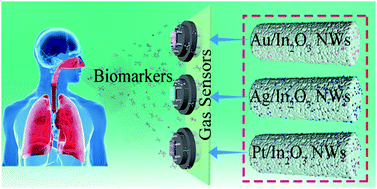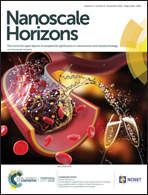Understanding the noble metal modifying effect on In2O3 nanowires: highly sensitive and selective gas sensors for potential early screening of multiple diseases†
Abstract
Detection of multiple volatile organic compounds in human exhaled breath using semiconductor oxide-based sensing devices has attracted increasing attention for the early diagnosis of diseases. However, detecting trace levels of exhaled biomarkers with high sensitivity and selectivity remains a challenge and the corresponding mechanism for the selectivity is still unclear. Herein, ultrafine In2O3 nanowires (NWs) modified with Au, Ag, and Pt noble metal nanoparticles (NMNPs) are synthesized using the electrospinning method and are used to build semiconductor sensors. It is exciting to observe that the introduction of NMNPs can not only enhance the sensing performance, but also effectively adjust the selectivity. The Au-, Ag- and Pt-modified In2O3 NW sensors exhibit excellent selectivity to hydrogen sulfide, formaldehyde, and acetone biomarkers, respectively. To completely understand the mechanism, theoretical simulation is performed based on density functional theory, which demonstrated that the specific absorption energies between the modified In2O3 NWs and the target gases along with the “spillover effect” resulted in excellent specific selectivity. Importantly, the NMNP modified In2O3 NW sensors are successfully used to build a sensor array for effective simultaneous detection of simulated exhaled breath. The present work provides a simple, low-cost, effective tool for early screening of halitosis, breast cancer, and diabetes at the same time and an in-depth understanding of the enhanced sensing performance by the introduction of NMNPs.

- This article is part of the themed collection: Nanoscale Horizons Most Popular Articles


 Please wait while we load your content...
Please wait while we load your content...